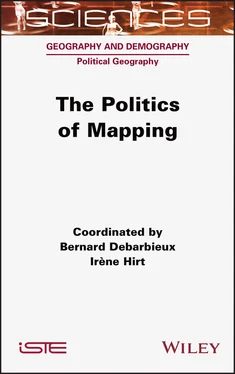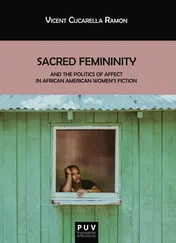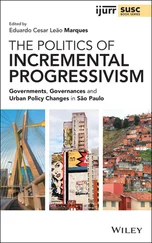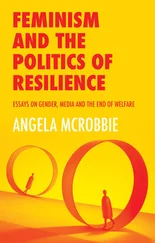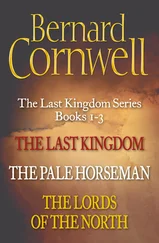This turning point is all the more significant because Harley was followed by many authors who produced a significant body of empirical or theoretical analysis. Even today, his proposals continue to inspire researchers. Indeed, referring to the idea of “critical cartography” quickly became a standard, particularly in the English-speaking academic world, at a time when geographical analyses in terms of power relations and domination were also multiplying. From that moment on, the political dimension of critical cartography has tended to be emphasized (Crampton and Krygier 2006, p. 11). This has resulted in considerable and exciting academic output. Initially, this focused primarily on the role of mapping both in the history of modern state-building in Europe (Buisseret 1992; Kain and Baigent 1992) and colonial empires (Kain and Baigent 1992; Edney 1997; Blais 2014) – leading, in the process, to the negation of Indigenous peoples, especially in the Americas (Harley 1990, 1992) – as well as in the process of decolonization (Akerman 2017). However, it has also looked at the diffusion of the modern state model outside European colonies (Winichakul 1994).
On the strength of these case studies and the constant enrichment of the field that has been made possible, critical cartography acquired significant visibility in the last two decades of the 20th century, thanks to a number of exhibitions 2and critical works, including Denis Wood’s The Power of Maps (1992), Mark Monmonier’s How to Lie with Maps (1991), and the ambitious collection of volumes, The History of Cartography , launched in 1987 by Harley and David Woodward (1987), to which we will return later. Critical cartography has also become globalized through the translation of some of Harley’s texts 3and the publication of analyses made by authors whose approaches were similar to his 4but who write in languages other than English (e.g. Jacob 1992; Gugerli and Speich 2002; Valerio 2007). This visibility has enabled maps and mapping to occupy an important place in the work of major authors on the issues of nationalism (Anderson 2006 [1983]) and the state (Scott 1998), despite them being outside the field of critical cartography itself.
However, this account of the critical and political turn taken by cartographic thinking, while bringing to light a very important moment in the history of mapping, which was stabilized by being endlessly revisited by academic production, is not fully satisfactory, nor is it complete. There are several reasons for this.
I.1.2. Pluralism and taking perspectives further
First of all, this narrative pays little attention to the reflections and work that preceded the “Harleyian turning point”. Throughout the 20th century, and well before the 1970s, geographers emphasized the use of maps for political purposes.
Isaac Bowman, for example, director of the American Geographical Society and Chief Territorial Specialist , appointed by Woodrow Wilson to advise the American delegation to the Paris Conference in 1919, was astonished by the quantity of contradictory linguistic and ethnic maps placed on the negotiating table to decide the European borders in the aftermath of the First World War, each illustrating the claims of the states concerned (House and Seymour 1921; Smith 1984). In the aftermath of the Second World War, Hans Speier and a few others analyzed Nazi propaganda maps, showing the fundamentally rhetorical and persuasive nature of maps (Speier 1941) 5. Finally, authors relying on Marxist theories, such as Yves Lacoste with the topographic map (Lacoste 1976), have endeavored to show how mapping has served the objectives of military, social or imperialist domination. In comparison with the production of previous decades, the “Harleyian turning point” can hardly be characterized by the mere (re-) discovery of the political nature of maps.
Besides, this “turning point” is not characterized by a single problematization of the coupling between maps and politics nor by a stable body of theoretical references. It is true that Harley favored a critical interpretation of the map very early on; in doing so, he was concerned with placing it in its social context of production. However, at first, this interpretation was also mainly fed by Marxist theories and questioning (as in Harley 1988a, pp. 277–312). It was only gradually, under the influence of very different postmodern authors – Roland Barthes, Jacques Derrida and Michel Foucault (who we are still surprised to see grouped under the single banner of “French theory” in the English-speaking world) – that Harley called for a research program aimed at “deconstructing” (Harley 1989) the map, “denaturalizing” it in the opposite direction to what the modernist project had sought to do, and recognizing within it intentions that were indistinguishable from the productions. In this respect, Harley’s work is not isolated. It is nourished by numerous new reflections on maps and mapping, as shown by the reference to the catalog of the exhibition “ Cartes et figures de la terre ”, organized in Paris in 1980 (Centre Georges Pompidou 1980), in his first theoretical text on the subject (Blakemore and Harley 1980). Moreover, this work was undertaken in parallel with others who drew, in part, on the same theoretical references: this is the case of Claude Raffestin, who was undoubtedly the first European geographer to take advantage of the Foucauldian method to analyze geographic and cartographic discourse, for example, when he wrote: “The zenithal gaze is dominant by nature and is inscribed in the desire to see everything in order to know everything and to be able to do everything” (Raffestin 1988, p. 136 author’s translation; see also Raffestin 1979).
Drawing on Foucault’s early work, Harley emphasized the disciplinary and authoritarian potential of state mapping. Many of those who have extended his work, however, have favored Foucault’s second generation of work, particularly that devoted to the notion of governmentality. In doing so, attention shifted from topographic and political maps to thematic maps, which better reflected the need for knowledge and the control of populations and were even more easily manipulated than topographic maps (Raffestin 1988, p. 137). With this view, John Pickles wrote in 2004 that “mapping as a power-knowledge also functions as productive power to constitute objects, identities and practices that are part of (and constitutive of) our world” (Pickles 2004, p. 114). Mapping is therefore of interest as much for its contribution to the territorialization of state power as for its participation in the adoption and dissemination of hegemonic concepts of territoriality. Such analyses lead several authors to think of the map as a condition for the territoriality of the modern state (Winichakul 1994; Kitchin and Dodge 2007; Debarbieux 2019), and for that of modern societies as a whole. Pickles himself puts it this way, “Maps and mappings precede the territory they ‘represent’” (Pickles 2004, p. 5).
This kind of thinking has led Joe Painter to speak of “cartographic anxiety” in order to refer to the need of states (but also any other political entity) to have a territory whose very nature can be shaped by maps: “I want to suggest that dominant understandings of concepts such as ‘territory’ and ‘region’ have been structured in important ways by cartographic reason, and therefore that related practices of territorialization and regionalism are generated, in part, by cartographic anxiety” (Painter 2008, p. 346). At this point, the interpretation of the map as an instrument of power has seen its epistemological character coupled with an ontological one: it participates in an ontogenesis of the state and the corresponding society. In this book, Franco Farinelli’s chapter on the role of mapping in the spatial production of modern societies ( Chapter 2) and Bernard Debarbieux’s chapter on the cartographic production of modern states ( Chapter 5) attempt to explain and illustrate this perspective.
Читать дальше
